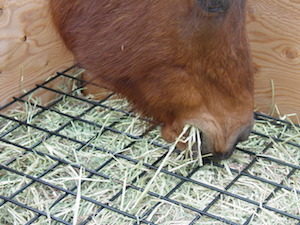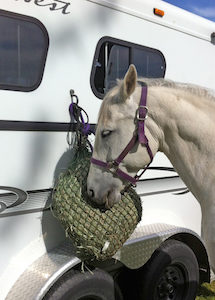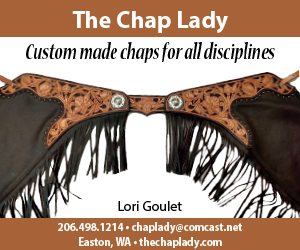Uses and Misuses of Commonly Used Horse Feeders
by Juliet M. Getty, Ph.D.

Forage is the foundation of every equine’s diet and needs to flow steadily through the digestive tract. Gaps without forage can lead to ulcers, colic, behavioral issues, stall vices, gorging, choke, cribbing and even laminitis. Truly, the only way to avoid these problems is to allow your horse steady access to forage, free-choice, all day and all night. Responding to this inherent need is the slow-feeder industry. The purpose of this article is to provide a clear understanding of slow-feeders and how they can be used safely and effectively. There are many styles and types from which to choose. The best approach is to contact several manufacturers to see which product best meets your horses’ needs.
The purpose of a slow-feeding system is to simulate grazing. Horses in a natural setting eat small amounts of forage as they wander in search of the next tasty morsel. They eat virtually all day and night, taking time to socialize and rest every so often for a few minutes at a time. When they know that they always have access to forage, they become calm and relaxed, rest more often, and walk away from their hay, knowing that it will still be there when they return. In other words, they “self-regulate” and eat only what they need to maintain a healthy body condition.

Forage restriction is incredibly stressful. Why should this matter? Because stress causes the release of the hormone cortisol, which in turn leads to elevated insulin. When insulin is high, it tells the body to store fat. Your goal? Get rid of the stress. Feed an appropriate forage (low in sugar and starch) free-choice and allow the horse to tell you how much he needs. There are some horses, however, who gain weight very quickly when given forage free-choice. The reason has to do with the sluggish metabolic rate they’ve developed over time. When forage is parceled out only a few times a day, the horse responds by going into “survival mode,” where his metabolic rate significantly slows down in an attempt to conserve body fat. A cycle of ever-increasing obesity is created that can be reversed only through exercise and removing the hormonal fat-storing response. Slow-feeders, when used properly, are an excellent way to reduce stress. As their name suggests, they slow down the rate of consumption by providing hay through small openings. When slow feeders are kept full, they allow the horse to graze whenever he wants, thereby encouraging the horse to eat less and still have constant forage.
Chewing with the head low is more in line with the horse’s natural physiology, creating even pressure on the teeth and allowing the jaw bone to move freely in all directions. Furthermore, the muscles, joints, tendons, ligaments and bone structure are not stressed when horses can grab hay in a straight downward motion. Eating with their heads down also protects their eyes and respiratory tract against mold spores and dust and provides for better nasal drainage.
How to Start and Types of Slow-feeders
Use at least two feeders per horse and place them as far apart as possible. Even if your horse is in a stall or small paddock, place one on either end of the area. Many slow-feeders made of hard material can accommodate two or possibly three horses at a time, but it is preferable to have more feeders to encourage movement, satisfy the horse’s natural curiosity, and minimize squabbles among herd members. Gradually allow your horse to become accustomed to this method of feeding by placing some hay in the feeder as well as loose on the ground next to it. After a few days, most horses will get the hang of the slow-feeder. Some take longer, so don’t force the issue; let your horse get used to it at his own pace. If your feeder contains a grate, leave it off for a few days as your horse becomes familiar with lowering his head inside the feeder. Once you add the grate, pull hay through the openings to help get him started. Supervise your horse during this period, watching for signs of frustration. Frustration is a form of stress and needs to be avoided.

Hay nets are not the same as slow-feeder nets. Hay nets typically have very large openings in which your horse can easily become tangled. Slow-feeder nets provide openings that are much smaller. I recommend 1.5 to 1.75 inches for a full-sized horse; anything smaller may cause undue frustration. Fatigue can also set in, causing the horse to stop eating. On the other hand, if the hole is too large the horse will typically eat as much as if the hay were loose on the ground. Researchers at the University of Minnesota demonstrated that horses took longer to consume their hay as the hole size was decreased. Therefore, it is best to choose a hole size that will slow down feeding, but not so small that it induces exasperation. It is best to purchase these nets from a reputable manufacturer rather than try to make your own. Cheaper fabrics can unravel and break, potentially damaging teeth and worse (such as colic if your horse swallows fibers). Commercial products are made from heavy duty fabrics that resist tearing and fraying, and provide safety features as well as customer support.
The best hard slow-feeders are made of sturdy plastic or hard rubber that will not crack in very hot or cold temperatures and can withstand the abuse of being kicked or stepped on. Avoid wooden feeders. You might be tempted to build your own by placing a steel grid on top or on open sides of a container. This can create several hazards including: a high potential for sharp edges; clips can get caught on halters or catch an ear or eyelid; grids can tilt; shod horses can trap a foot on the metal openings; metal grates can damage teeth (horses can even get a tooth caught in this type of grid), and grated vertical sides force the horse to turn his head sideways leading to neck strain. Instead, buy your feeder from a reputable manufacturer. Common styles include the hay basket: this consists of a round metal frame which holds a removable plastic basket with large slats to allow for drainage. Since the basket does not sit on the ground, the hay stays dryer. Barrel or box type feeders: These are well received by many horses however, some find lowering their head inside a container to be mentally uncomfortable. Nevertheless, it is better to choose one that sits on the ground rather than forcing your horse to pull hay out from the bottom of a barrel that is hung. Make sure the openings are large enough and preferably rounded to prevent damage to the horse’s mouth and teeth.
Advantages of Slow-feeder Nets
- They come in a variety of sizes that can hold a few flakes, a whole bale, or even an entire round bale.
- There is flexibility in mounting them. Many can be attached to a wall, tree, or sturdy post at a low level. Some are designed to be on the ground, allowing the horse to eat in a more natural position.
Potential Problems:
- If there is room behind the bag, the horse could potentially get his head caught. If the fabric tears, a foot could get tangled in the net.
- If the horse is shod, the net must be secured within a bin; you can also hang them high enough to prevent a shoe or nail from snagging on to the netting, but this will create an awkward eating position.
- If laid on the ground, they must either be totally loose (expect them to get dirty) or be securely mounted so the horse cannot get a foot or his head caught below the feeder.
- If dangled from a tree or post, it can quickly become a source of frustration as it sways with every attempt to get a bite of hay. This can defeat your purpose in regulating consumption. Furthermore, if the horse were to rear near a feeder hanging from a tree or placed high in a stall, he could trap a hoof.
- They need to be refilled frequently (unless a whole bale size is chosen). Horses that run out of hay (even for 10 minutes) will never get the message that hay is always there and will not self-regulate.
Advantages of Hard Slow-feeders:
- They allow the horse to eat with their heads in a natural position.
- They are easy to fill with hay.
- Feeding can be shared with more than one horse.
- Dust and dirt tends to flow to the bottom.
When given the chance, horses will self-regulate their intake of forage. We can encourage this grazing behavior through the use of slow-feeders. Using them correctly and respecting the horse’s need to graze at ground level will help give your horse the opportunity to enjoy a healthy, natural life.
Originally Published July 2014 Issue

Juliet M. Getty, Ph.D. is an independent equine nutritionist with a wide U.S. and international following. Her research-based approach optimizes equine health by aligning physiology and instincts with correct feeding and nutrition practices. Dr. Getty’s goal is to empower the horseperson with the confidence and knowledge to provide the best nutrition for his or her horse’s needs. Learn more at www.gettyequinenutrition.com.






